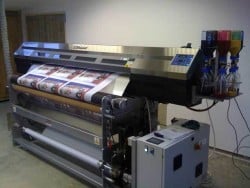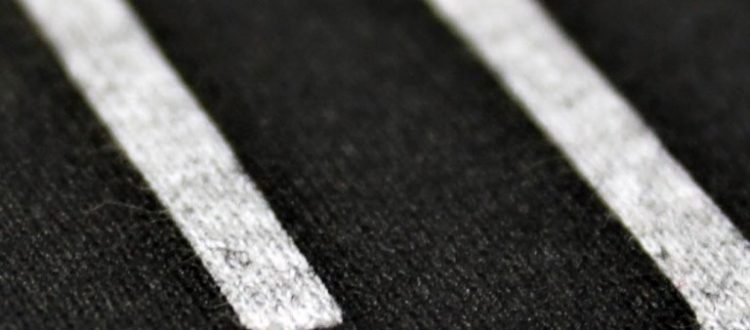Sublimating dyes onto darker substrates. And, what really happens when the dyes are sublimated onto the substrates.
Question: Is it possible to print dye sublimation inks onto darker substrates or fabrics.
You can do it, but it probably won’t look that great. The short answer would be, “why?” The longer answer follows.
Even double-sided fabric banner materials printed using dye sublimation barely pass the viewing test because there is just enough black block out visible to make the material appear slightly grayish-white.
Make no mistake about this…it is going to affect the color of your print. A bright red may now show up as a slightly less bright red, and a yellow will also be affected slightly toward a duller yellow as well.
If the print is a photographic print, and it covers the entire background of the banner, it will not likely show up much because the eye will adjust to the print. If there is a lot of white showing, most people will not pick up the slight diminution of the coloring on the print, but an astute observer might.
If you were to use a red or blue material, though, you might be able to sublimate a black image onto a colored material, but it might be difficult to find the material to create this bi-chromatic style of print from any printable fabric distributor.
This would, of course, beg the question as to why you would even want to start with red when you could just as easily sublimate print a bi-chromatic image on a white fabric anyway.
Question: What exactly is dye sublimation printing?
Even though I’ve answered similar questions in previous posts, I enjoy explaining dye sublimation printing on fabrics and cloth and other substrates because the science of dye sub printing is fascinating to me.
 I have no idea how someone came up with the idea of printing dye on a treated paper, marrying it to a piece of fabric, rolling it between heated rollers at high pressure to create a gaseous explosion which gets sealed into the polymeric cellular structure of polyester fabrics and other polymeric treated surfaces. Who thinks up these things!?
I have no idea how someone came up with the idea of printing dye on a treated paper, marrying it to a piece of fabric, rolling it between heated rollers at high pressure to create a gaseous explosion which gets sealed into the polymeric cellular structure of polyester fabrics and other polymeric treated surfaces. Who thinks up these things!?
If you didn’t’ quite get that last paragraph, let me describe it in a little more detail, one process at a time.
The Ink Set
Printing: Dye sublimate printing uses a CMYO ink set. This is similar to CMYK, but instead of Cyan-Magenta-Yellow-Black, it uses Cyan-Magenta-Yellow-Overprint. The overprint ends up black through some chemical process that I haven’t yet figured out, but obviously, someone has because it works.
The Paper
This dye/ink is printed onto a special paper known simply as dye sublimation transfer paper. This part of the process is similar to digital inkjet printing and is pretty recognizable in this century as a standard style of printing.
Heat Transfer of Print from Paper to Fabric
Transferring the Print to Fabric: The next step involves “marrying” the paper to the substrate, which in this case will be a piece of polyester fabric for use on a trade show display. Although any polymer-based fabric will work, the favorite material that has emerged is polyester. Polyester fabric can be anything from a sheer material to a satin to a knit and more.
The Dye Sublimation Process
The paper and the fabric are then placed onto the pressure unit, which has rollers that heat to around 400ºF in this instance (there are other flat units as well as units that are used for not flat items). They are then fed through the heated rollers at a slow rate of speed.
As the paper and the cloth go into the rollers, the heat and pressure create a gaseous “explosion” and the dye is converted to a colored gas (whatever color the dye was), and the polymers expand to open like a flower in the sun, and the gas pours into these open pores, and just as quickly, as the material cools, the polymeric pores close again, but now with continuous color tones that have created a photographic reproduction of the print that was in the computer, then printed to the transfer paper, and now is permanently bonded to the fabric. Or rather has become a part of the fabric.
This amazing print process has created a revolution in graphics that didn’t exist before dye sublimation, and even though dye sublimation has been around for quite some time, it made it’s way into the display industry with the advent of digital printers, and is becoming more popular by the year now, it seems.
Click here to see fabric graphics that can be printed through dye sublimation.
Popular Posts:





Banner Printing is smart way for adverting to your business, also Graphics are available in HD resolution, and it’s really powerful display medium and fabric banners can be hanging using a rope, attached with Velcro, or stretched over a stand to fit every display situation.